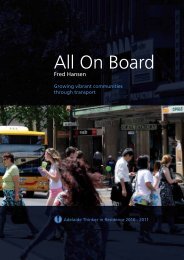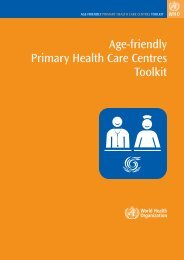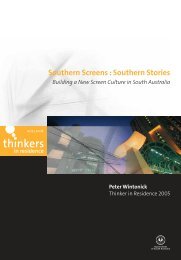Manufacturing into the future - Adelaide Thinkers in Residence - SA ...
Manufacturing into the future - Adelaide Thinkers in Residence - SA ...
Manufacturing into the future - Adelaide Thinkers in Residence - SA ...
- No tags were found...
Create successful ePaper yourself
Turn your PDF publications into a flip-book with our unique Google optimized e-Paper software.
1.5 South Australia needs a more balanced manufactur<strong>in</strong>g sector• Accord<strong>in</strong>g to IBIS World data w<strong>in</strong>e, iron, steel, copper, silver, lead and z<strong>in</strong>cmanufactur<strong>in</strong>g have a turnover equal to <strong>the</strong> rest of South Australia’s manufactur<strong>in</strong>g<strong>in</strong>dustry comb<strong>in</strong>ed. A rebalanc<strong>in</strong>g is needed to reduce <strong>the</strong> state’s economic risk and toenable <strong>the</strong> state to benefit from any rapidly emerg<strong>in</strong>g opportunities, for example, <strong>the</strong>resources boom.• Without a manufactur<strong>in</strong>g strategy South Australia will not have a diverse and capablemanufactur<strong>in</strong>g sector. A well-balanced and capable manufactur<strong>in</strong>g sector shouldbe able to convert <strong>the</strong> comparative advantages represented by local resources, forexample, m<strong>in</strong>erals, wheat, grapes, apples, wood and wool <strong><strong>in</strong>to</strong> competitive advantages.Without such a balanced and capable manufactur<strong>in</strong>g sector, <strong>the</strong>re is a risk of SouthAustralia experienc<strong>in</strong>g <strong>the</strong> surpris<strong>in</strong>gly strong downside of a resources boom.• Compared with lead<strong>in</strong>g manufactur<strong>in</strong>g nations South Australia needs to <strong>in</strong>crease <strong>the</strong>value add and productivity <strong>in</strong> manufactur<strong>in</strong>g firms. This is frequently enabled through<strong>in</strong>vestments <strong>in</strong> <strong>in</strong>tangibles like tra<strong>in</strong><strong>in</strong>g, digitalisation of operations, research anddevelopment.1.6 As part of <strong>the</strong> Australian national resources boom South Australiais on <strong>the</strong> threshold of develop<strong>in</strong>g Dutch DiseaseS U M M A R Y O F K E Y F I N D I N G S• Dutch Disease can be characterised by:- An <strong>in</strong>creas<strong>in</strong>g demand for labour from <strong>the</strong> boom<strong>in</strong>g resources sector, result<strong>in</strong>g <strong>in</strong> aproduction shift from <strong>the</strong> manufactur<strong>in</strong>g and service (or non-traded) sectors to <strong>the</strong>resources sector. This effect, although visible, is not normally a major problem s<strong>in</strong>ce<strong>the</strong> boom<strong>in</strong>g sector is capital <strong>in</strong>tensive ra<strong>the</strong>r than labour <strong>in</strong>tensive and hence doesnot employ a large number of people as a share of <strong>the</strong> total economy.- The extra revenue generated by <strong>the</strong> boom<strong>in</strong>g sector results <strong>in</strong> a spend<strong>in</strong>g effect whichtakes <strong>the</strong> form of <strong>in</strong>creased demand for offer<strong>in</strong>gs from <strong>the</strong> services (or non-traded)sector. This <strong>in</strong>creased demand moves labour away from <strong>the</strong> manufactur<strong>in</strong>g sector.- Increased demand for non-traded goods (or services) results <strong>in</strong> <strong>in</strong>creased pricesfor <strong>the</strong>se goods. This is to be compared with <strong>the</strong> prices of <strong>the</strong> goods <strong>in</strong> <strong>the</strong>manufactur<strong>in</strong>g sector which are set <strong>in</strong>ternationally and hence cannot change as aconsequence of changes <strong>in</strong> domestic conditions. This outcome can be seen <strong>in</strong> <strong>the</strong>form of an <strong>in</strong>crease <strong>in</strong> purchas<strong>in</strong>g power of <strong>the</strong> domestic currency relative to o<strong>the</strong>rcurrencies.• Allow<strong>in</strong>g a shift away from manufactur<strong>in</strong>g will be detrimental to <strong>the</strong> long-termwellbe<strong>in</strong>g of <strong>the</strong> State. It takes longer and is much more complex and costly to rebuilda competitive manufactur<strong>in</strong>g <strong>in</strong>dustry than it is allow<strong>in</strong>g it to die. A case can bemade that <strong>the</strong> cost of rega<strong>in</strong><strong>in</strong>g a lost competitive manufactur<strong>in</strong>g sector can be higherthan <strong>the</strong> net ga<strong>in</strong>s from <strong>the</strong> resource boom. This is due to <strong>the</strong> relatively lower speed oftechnology growth <strong>in</strong> <strong>the</strong> boom<strong>in</strong>g resource sector and <strong>the</strong> services (non-traded goods)sector as compared to <strong>the</strong> manufactur<strong>in</strong>g (traded goods) sector.• There are two means to reduce <strong>the</strong> risk of Dutch Disease. The first is to slow down <strong>the</strong>appreciation of <strong>the</strong> real exchange rate (this is a federal issue and is <strong>the</strong>refore outside of<strong>the</strong> objectives of this Residency). The second is to <strong>in</strong>crease <strong>the</strong> competitiveness of <strong>the</strong>manufactur<strong>in</strong>g sector. This will require a number of simultaneous actions, for example:- <strong>in</strong>vestment <strong>in</strong> education aimed at and for <strong>the</strong> manufactur<strong>in</strong>g sector- <strong>in</strong>vestment <strong>in</strong> <strong>in</strong>frastructure benefit<strong>in</strong>g <strong>the</strong> manufactur<strong>in</strong>g sector- encourag<strong>in</strong>g <strong>in</strong>novation <strong>in</strong> <strong>the</strong> manufactur<strong>in</strong>g sector through <strong>the</strong> implementation ofdemand side policy toolsGÖRAN ROOS : MANUFACTURING INTO THE FUTURE7
















